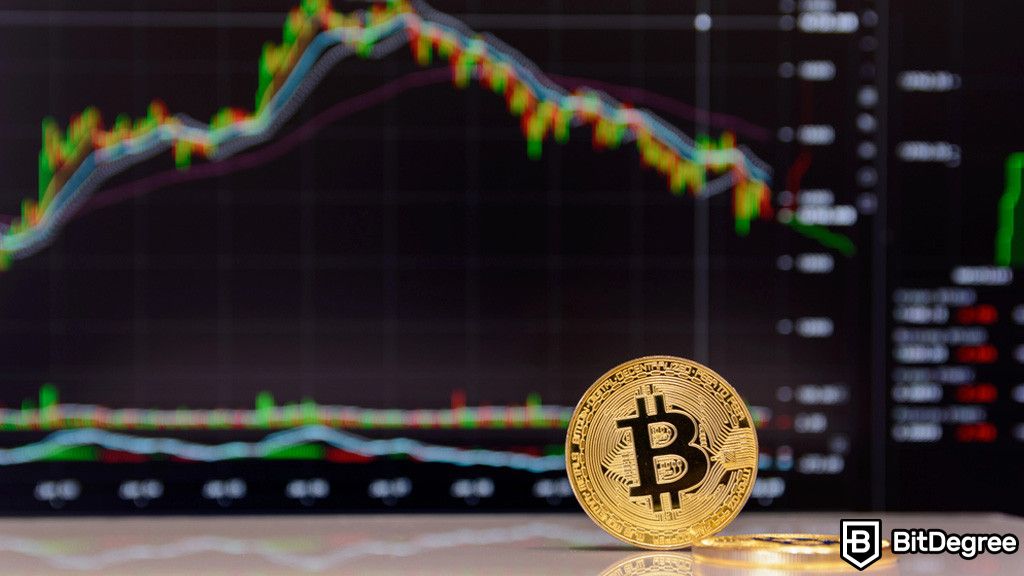Key Takeaways
- Understanding crypto chart patterns helps traders recognize price movements and make more informed decisions.
- Though useful, these patterns can’t guarantee a certain outcome.
- Applying risk management techniques, such as setting stop-loss orders, is very important to avoid significant financial losses.
Free Airdrop Season 7 is LIVE! Answer fun questions or do simple tasks to earn rewards from the $30K BitDegree prize pool. Participate Now ! 🔥
As you dip your toes into crypto trading, you’ve probably seen these graphs with a bunch of up-and-down lines. Yes, these are crypto chart patterns, visual charts that represent the price changes of cryptocurrencies, such as Bitcoin, Ethereum, and others.
Crypto traders use these charts to predict market behavior and pinpoint the best timing to buy or sell assets. Simply said, crypto chart patterns play a significant role in how traders make their trading decisions. At this point you must be wondering, how do you read these charts? Well, you’ve come to the right place.
In this article, I will guide you to the basics of crypto chart patterns, the common graph patterns you need to know, and how to use them optimally in your trading activities. We will also look at three top crypto exchanges such as Binance, KuCoin, and Coinbase, where you can apply your newfound knowledge of crypto chart patterns.

Did you know?
Subscribe - We publish new crypto explainer videos every week!
What is Polygon in Crypto? (Animated Explainer)


Table of Contents
- 1. Basics of Crypto Chart Patterns and Technical Analysis
- 1.1. Time Frames in Crypto Charts
- 2. Common Types of Crypto Trading Patterns
- 2.1. Head and Shoulders (and Inverse Head and Shoulders)
- 2.2. Double Top and Double Bottom
- 2.3. Triangles (Symmetrical, Ascending, and Descending)
- 2.4. Flags and Pennants
- 2.5. Wedges (Rising and Falling)
- 2.6. Cup and Handle
- 2.7. Fibonacci Retracement Levels
- 3. Practical Tips for Trading Using Crypto Patterns
- 4. Choosing Your Crypto Exchange
- 4.1. Binance
- 4.2. KuCoin
- 4.3. Coinbase
- 5. Conclusion
Basics of Crypto Chart Patterns and Technical Analysis
As I mentioned earlier, a crypto chart pattern represents changes in cryptocurrency prices over time. These prices will go up and down depending on the collective actions and sentiments of market participants, forming some sort of pattern. Traders analyze these crypto graph patterns to predict future price movements, identifying potential buy or sell signals based on historical trends.
Latest Deal Active Right Now:Head to BitDegree Missions, gather as many Bits as possible & claim your stake of the $30,000 Prize Pool! Don't waste your time & start collecting Bits by completing Missions and referring friends.
The whole process of analyzing crypto chart patterns is called “technical analysis”. To put it simply, technical analysis is a way to look at market data to spot patterns and trends. It's based on the idea that what happened in the market before is likely to happen again[1].
Technical analysis plays a crucial role in identifying crypto patterns using various tools and indicators, such as trend lines, moving averages, and chart formations.
Basically, you don’t want to go willy-nilly when trading crypto, unless you want to experience massive losses. Proper crypto trading requires a lot of planning and research to ensure you get the most out of your investment. This includes reading crypto charts.
However, keep in mind that crypto chart patterns are not the end-all-be-all guide to crypto trading. Considering how young it is, the crypto market can be very volatile and unpredictable. That being said, do not take this article as an investment or financial guide. This article is intended to educate you about the concept of crypto chart patterns.
I encourage you to always consult a professional financial advisor before making any investment decision.
Time Frames in Crypto Charts
Another thing every trader should understand when reading crypto chart patterns is the time frame. It refers to the selected duration that each data point on a chart represents. Essentially, it's the scale at which you're viewing the market movements.
Time frames can range from very short to very long periods, and they are crucial for traders because they align with different trading strategies and objectives. There are three main types of time frames in crypto chart patterns:
- Intraday time frames: These are short-term time frames that show price movements within a single trading day. They can be as short as one minute, five minutes, 15 minutes, 30 minutes, or one hour. Intraday time frames are often used by day traders who want to take advantage of small price movements within the day.
- Daily time frames: These time frames show the price movement of a cryptocurrency for one trading day. It’s useful for traders looking to hold positions for one day to several days.
- Weekly and monthly time frames: These are longer time frames that show the price movement over weeks or months, respectively. They are preferred by swing traders and long-term investors who are looking for broader market trends and are less concerned with short-term fluctuations.
Choosing the right time frame is subjective and depends on an individual's trading style, risk tolerance, and goals. Some traders might even use multiple time frames to get a more comprehensive market view. For example, a trader might use a longer time frame to identify the general trend and a shorter time frame to find precise entry and exit points.
Common Types of Crypto Trading Patterns
Crypto chart patterns can be broadly categorized into continuation patterns, indicating that the current market trend is likely to persist, and reversal patterns, suggesting a potential change in the market direction.
These patterns can take various shapes, such as triangles, rectangles, head and shoulders, or cup and handle formations, each with its own predictive value and trading strategy implications. Here are more detailed explanations about how to interpret them.
Head and Shoulders (and Inverse Head and Shoulders)
The Head and Shoulders pattern is a chart formation that resembles a mountain with two smaller hills alongside it; the middle mountain (head) is the highest, and the two outside hills (shoulders) are lower and roughly equal in height. This pattern is usually formed in an uptrend and signals a potential reversal to a downtrend.

- Left shoulder: Formed by a price rise followed by a price fall.
- Head: After the left shoulder, there's a price rise that surpasses the height of the left shoulder followed by a decline.
- Right shoulder: Formed by a rise that does not exceed the height of the head followed by a decline back to the baseline (also known as the neckline).
When you see this pattern in a price chart, it's like the market is telling you, "I've tried to go higher a few times (the hills and the mountain), but I'm getting tired." If the price falls below the neckline after the right shoulder, it's a sign that prices might keep going down for a while. This is called a breakout.
There is also another version of this crypto chart pattern called the Inverse Head and Shoulders. As you can imagine, it is the upside-down version of the previous pattern which typically forms in a downtrend and signals a potential reversal to an uptrend.
An experienced trader would typically make sure the price moves beyond the neckline before they decide to buy or sell based on these crypto graph patterns. This helps ensure that the pattern is really happening. You can also confirm the pattern by checking the volume.
For the Head and Shoulders, when prices start to fall after the pattern forms, you want to see more people selling. On the other hand, for the Inverse Head and Shoulders, when prices start to rise, it's good if more people are buying.
Additionally, most traders would set a target price by looking at how big the pattern is. You can do this by measuring the distance between the top of the head and the neckline and using that to guess how much the price might go up or down after it breaks the neckline.
Double Top and Double Bottom
Double Top and Double Bottom patterns are like signals that a trend is about to change direction. Shape-wise, the Double Top is like seeing two mountain peaks at about the same height on a crypto pattern chart.
It happens in an uptrend when the price of the cryptocurrency rises to a peak, dips slightly, and then rises to the same peak again before falling for good. The area between the two peaks is the resistance level—the price point the currency struggles to rise above.

This crypto graph pattern suggests that the uptrend is losing steam, and a reversal to a downtrend might be near. The confirmation comes when the price falls below the lowest point between the two peaks, known as the neckline.
On the other hand, the Double Bottom pattern looks like two valleys at about the same depth. This occurs in a downtrend when the price drops to a trough, rebounds slightly, drops to the same level again, and then finally starts to climb. The area between the two troughs acts as a support level—the price point the currency doesn’t fall below.
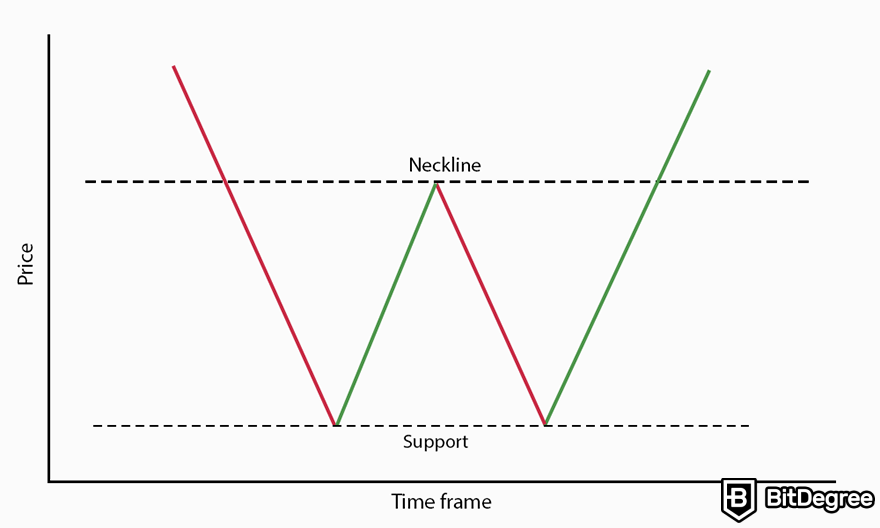
This cryptocurrency pattern indicates that the downtrend is running out of power, and a reversal to an uptrend could be coming. You can confirm the formation when the price rises above the highest point between the two troughs, known as the neckline.
For both crypto trading patterns, waiting for confirmation before making a trade is important to avoid false signals. The volume should ideally increase on the breakout, providing further confirmation of the pattern’s reliability.
Setting a target price based on the distance between the tops or bottoms and the neckline can help in planning the potential profit area for your trade.
Triangles (Symmetrical, Ascending, and Descending)
The Triangle crypto trading patterns signal that a cryptocurrency price is about to jump or drop big time. Imagine drawing lines that connect the tops and bottoms of where the price has been going. If these lines start to form a triangle shape, it means a big price move might be coming soon. There are three main types of triangle patterns: Symmetrical, Ascending, and Descending.
Symmetrical Triangle
Imagine drawing two lines along a price chart: one line connects lower highs where the peaks are getting lower, and the other connects higher lows where the valleys are getting higher. These lines approach each other, forming a triangle that points to the right.

This is a Symmetrical Triangle and indicates that buyers and sellers are unsure who will take control, causing the price to squeeze into a tighter range. The breakout direction from this crypto trading pattern can be up or down, depending on who wins the battle between buyers and sellers.
When you see this pattern, wait to see in which direction the price breaks out of the triangle. Above the upper line suggests a buy, while below the lower line suggests a sell.
Ascending Triangle
This triangle pattern is formed by a flat upper line (resistance) and an ascending lower line (higher lows). It suggests that buyers are more aggressive, consistently buying at higher prices, but are facing resistance at a certain price level.

An Ascending Triangle usually indicates that an upward breakout is likely, as buyers are attempting to push the price beyond the resistance level. The typical choice is to look for a breakout above the upper line to buy. A stop-loss can be placed just above the most recent low within the triangle.
Descending Triangle
Opposite to the Ascending Triangle, this pattern has a flat lower line (support) and a descending upper line (lower highs). It suggests that sellers are more aggressive, pushing the price down, but are hitting a floor that they can't break through.
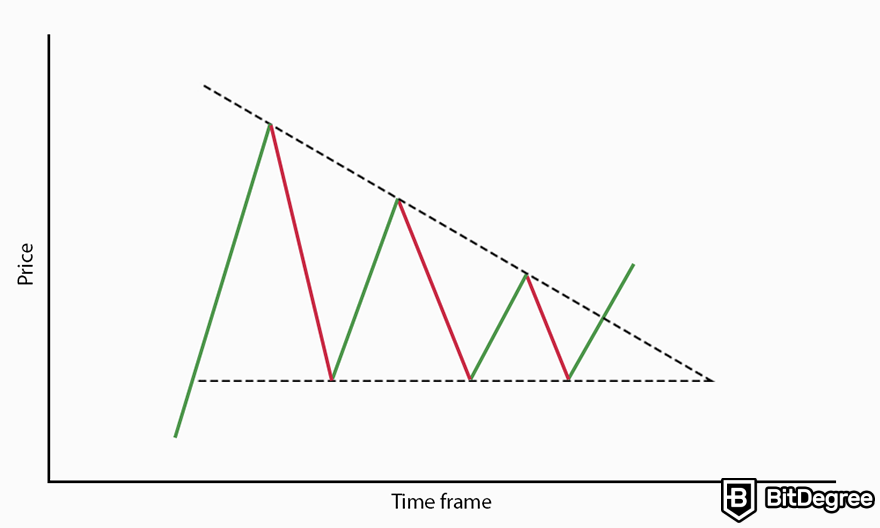
A Descending Triangle usually indicates that a downward breakout is likely, as sellers are trying to push the price below the support level. The most common strategy is to look for a breakout below the lower line to sell or short. A stop-loss can be placed just below the most recent high within the triangle.
General Tips for Triangle Patterns
Make sure to wait for a confirmation breakout before you decide to sell or buy in this crypto chart pattern. For example, a breakout with increased volume offers stronger confirmation. This means more traders are participating in the move, making it more likely to continue.
You can also estimate a price target by measuring the widest part of the triangle and projecting that distance from the breakout point. In most cases, a potential breakout is stronger when the pattern lasts for a longer period.

Did you know?
Subscribe - We publish new crypto explainer videos every week!
What is a Perpetual Contract in Crypto? (Definition + Example)


Flags and Pennants
Imagine you're watching a flag or a pennant fluttering on a flagpole. In trading charts, Flags and Pennants patterns look somewhat similar and signal that a quick, strong price move could soon continue in the same direction. Here's a simple breakdown:
Flags
A Flag pattern forms after a sharp move up or down, followed by a small, sloping rectangle that looks like a flag. This "flag" is formed by parallel lines that go against the initial sharp price move, also called a “pole”. So, if the price shot up quickly, the flag would slope down slightly as the market takes a brief pause.
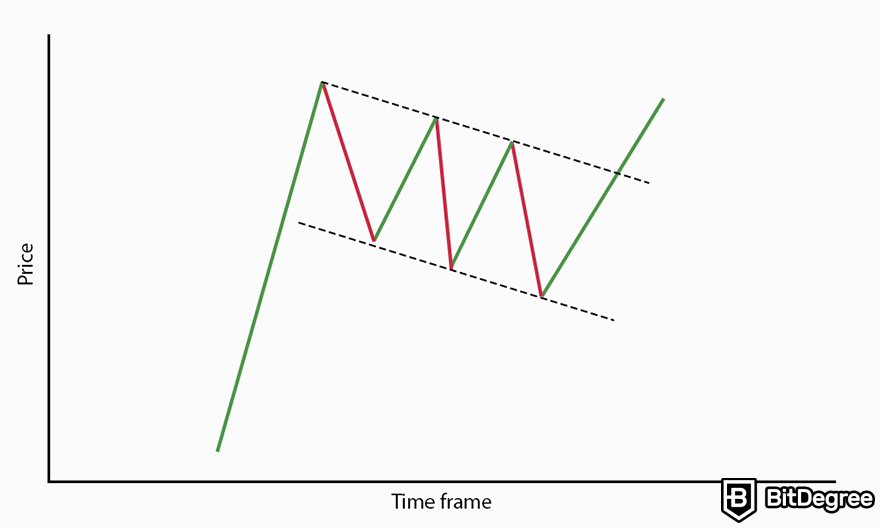
The Flag signals that the previous sharp movement (up or down) is likely to continue after this brief pause. For an upward Flag, an experienced trader would consider buying when the price breaks above the upper line of the flag. As for a downward Flag, they would consider selling or short-selling when the price breaks below the lower line. They’d also place a stop-loss just outside the flag to manage risk.
Pennants
A Pennant is similar to a Flag, but instead of a rectangle, the consolidation phase looks more like a small triangle or a pennant. After a strong price move, the Pennant forms converging trendlines that create a tiny symmetrical triangle, pointing to a continuation of the trend.
Like Flags, Pennants suggest that the fast move before them is likely to resume. You might want to buy on a breakout above the Pennant in an uptrend or sell/short on a breakout below in a downtrend. Again, setting a stop-loss just outside the Pennant pattern can help limit potential losses.

At a glance, the Pennant pattern might look similar to the Symmetrical Triangle. However, there are several key differences. First, Pennants typically develop over a shorter time frame. They are considered short-term patterns that form within a few weeks. On the other hand, Symmetrical Triangles can develop over a longer period, usually spanning several months.
Because of this, Pennants would typically look smaller compared to broader Symmetrical Triangles.
Pennants often follow a steep, almost vertical price movement (the pole), indicating a brief consolidation before the trend continuation. Symmetrical Triangles don't necessarily follow a vertical price movement. Instead, they form during a period of indecision where the highs and lows converge towards a central point over time, reflecting a balance between buyers and sellers without a preceding "pole."
In terms of breakout directions, Pennants usually suggest a continuation of the trend before the pennant formation. If the pennant forms after an up move, it suggests a continuation upward, and vice versa.
Symmetrical Triangles are considered neutral patterns where the breakout direction is uncertain until it happens. The price can break out in either direction, depending on market forces.
When encountering Flag and Pennant cryptocurrency patterns, traders would usually look for a spike in trading volume on the breakout, which can confirm its reliability. Consider measuring the pole to estimate how far the price might move after breaking out of the Flag or Pennant.
Wedges (Rising and Falling)
Think of a wedge as a piece of wood that you might use to keep a door open or closed. In trading charts, Wedges are crypto chart patterns that look similar but tell us about the potential future direction of price movements. There are two main types: Rising Wedges and Falling Wedges.
Rising Wedge
A Rising Wedge forms when the price is moving upward, but the slope of the lows (the bottom line of the wedge) is steeper than the slope of the highs (the top line). This means the price is making higher highs and higher lows, but they're coming together, making the wedge shape narrow at one end.
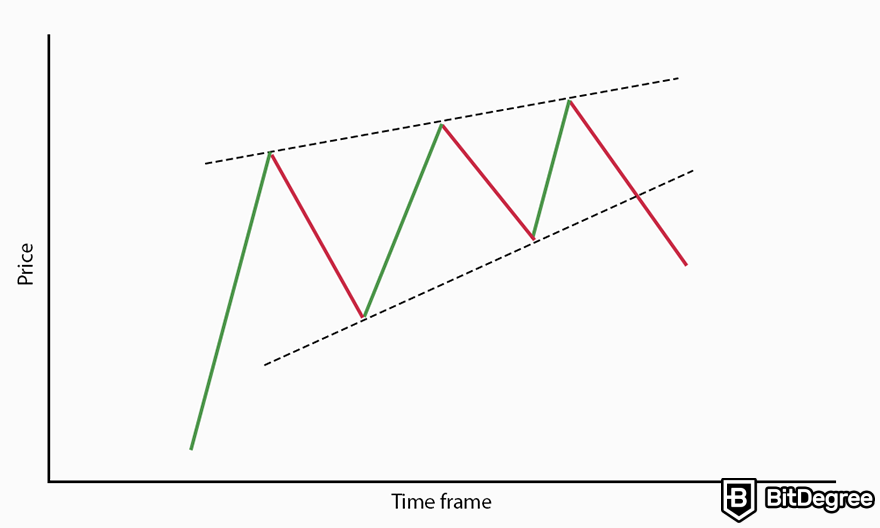
Despite the upward trend, a Rising Wedge is often seen as a downward signal. It suggests that an upward move is losing steam, and a reversal to a downtrend might be near. Most traders would consider selling or short-selling when the price breaks below the lower line of the wedge. A stop-loss can be placed above the most recent high within the wedge to minimize risk.
Falling Wedge
A Falling Wedge is the opposite of a Rising Wedge. It forms during a downtrend, with the slope of the highs being steeper than the slope of the lows. This pattern shows lower highs and lower lows that are converging, making the wedge shape narrow down.
Even though it appears during a downtrend, a Falling Wedge is usually an upward signal. It indicates that the downward momentum is weakening, and a reversal to an uptrend could be coming. The typical strategy used by experienced traders is to consider buying when the price breaks above the upper line of the wedge. Place a stop-loss below the most recent low within the wedge to protect against potential losses.
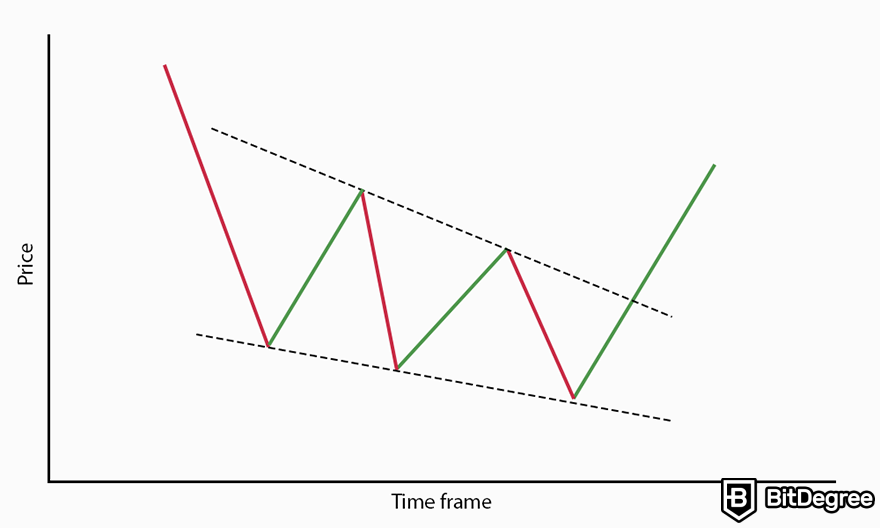
When you notice the signs of Wedge patterns, watch for a change in volume as the price breaks out of the wedge. A breakout with increasing volume can add confidence to the pattern's prediction. You can estimate the potential price move after the breakout by measuring the height of the wedge at its widest part and projecting that distance from the breakout point.
Cup and Handle
Just as the name suggests, this crypto chart pattern resembles a cup with a handle. It's usually considered a bullish pattern that starts after a price advance. Let’s break it down to make it easier to understand.
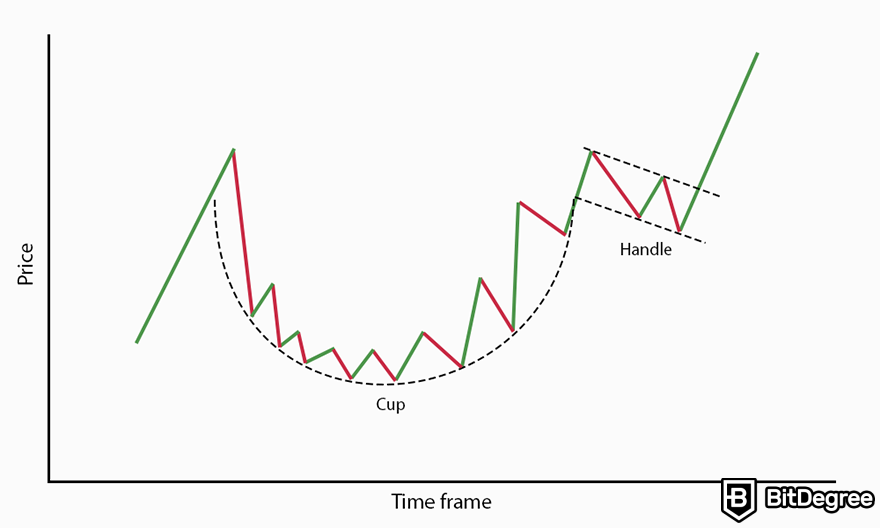
- Cup: The "cup" forms when the price first drops and then rises back to the start point, creating a U-shaped curve. This part of the crypto trading pattern can last from several weeks to many months. The bottom of the cup should be rounded; a sharp drop and rise typically don't qualify as a true Cup and Handle.
- Handle: After the cup is formed, the price undergoes a smaller downward drift, forming the "handle," which is a slight dip from the right side of the cup. The handle is typically shorter and shallower compared to the cup. It can look like a small wedge or flag pattern.
The Cup and Handle pattern typically signals that the cryptocurrency price might start going up again after taking a short break. Traders often look for a breakout from the handle to enter a long position. The breakout point would be when the price moves above the upper resistance level of the handle.
The depth of the cup can often be used to project the upward target price from the breakout point. For example, if the cup's depth is $100, the price target after the breakout would be $100 above the resistance line of the handle.
Ideally, the volume should decrease during the formation of the handle and then increase significantly during the breakout, signaling strong buying interest.
It’s worth pointing out that the formation of a Cup and Handle pattern takes time, so you need to be patient and let it fully develop before taking a position. To manage risk, consider placing a stop-loss order below the handle or the most recent low within the handle.
Fibonacci Retracement Levels
Fibonacci Retracement Levels are based on a series of numbers called the Fibonacci sequence, where each number is the sum of the two preceding ones (0, 1, 1, 2, 3, 5, 8, 13, 21, ...). In crypto trading, these numbers are turned into percentage levels that help predict where the price might find support or resistance after a big move.
These levels are 23.6%, 38.2%, 50%, 61.8%, and sometimes 78.6%. To draw these levels on a crypto trading chart, you pick a high and low point of a price movement. The retracement levels will appear between these two points, acting like invisible barriers where the price might pause or reverse.
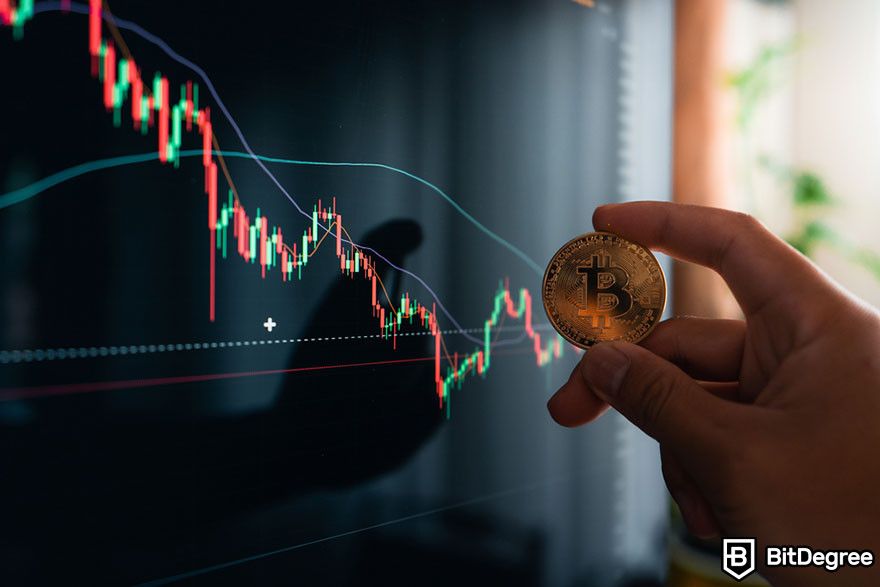
Let me give you an example scenario to help make this easier to understand.
Imagine you're a trader who's been watching Bitcoin's price increase from $10,000 to $20,000 over the last month. This big move catches your attention, and you think it's a good opportunity to use Fibonacci Retracement Levels to plan your next trade.
First, you use a trading platform that allows you to draw Fibonacci Retracement Levels on the price chart. You set $10,000 as your low point (start of the price increase) and $20,000 as your high point (end of the price increase). The platform automatically draws lines at key percentages between these two points: 23.6%, 38.2%, 50%, 61.8%, and sometimes 78.6%.
After hitting $20,000, Bitcoin's price starts to fall, which is normal because prices don't go up forever—traders take profits, causing the price to drop. You notice the price dropping towards these Fibonacci Levels, looking for signs of support where the price might stabilize or bounce back up.
The price of Bitcoin goes down to around $16,180, which is the 61.8% Fibonacci Level. You notice the price starts to stabilize around this level, showing signs that it might not go much lower. This level is known for being a strong support area based on Fibonacci theory.

Seeing the price stabilize around the 61.8% level, you decide it's a good time to buy Bitcoin, expecting that the price will start to rise again. You think of this level as a trampoline that Bitcoin is likely to bounce back up from.
You set a target for where you'll take profits, maybe just below the previous high of $20,000, anticipating it might not break the high on the first try. You also set a stop-loss order below the $16,180 level, in case the price decides to continue falling, to minimize your potential losses.
Turns out, after buying at the 61.8% retracement level, the price of Bitcoin begins to rise again over the next few days or weeks, allowing you to sell near your target price for a profit. This trade worked out because you used the Fibonacci Retracement Level as a guide to find a potential turning point in the market.
The key is observing how the price reacts at these levels, which can act as either support (for a price drop) or resistance (for a price rise), and then making trading decisions based on this cryptocurrency pattern, combined with other market indicators and risk management strategies.
Practical Tips for Trading Using Crypto Patterns
At this point, hopefully, you’ve understood more about crypto chart patterns and how they work.
To help you implement them better, here are 10 tips that can help you make more informed decisions when reading these patterns for trading.
- Trend is your friend: Always consider the overall trend of the market before making decisions based on crypto chart patterns. These patterns tend to be more reliable when they align with the prevailing trend.
- Look for confirmation: Don't act on a crypto chart pattern until it's fully formed and confirmed. For example, a breakout from a pattern with increased volume can serve as a confirmation signal.
- Volume matters: Pay attention to trading volume. A genuine breakout or trend reversal is often accompanied by a significant change in volume.
- Use multiple time frames: Analyze crypto chart patterns across different time frames for a more comprehensive view. A pattern that appears across several time frames may be more significant.
- Manage risk: Always have a risk management strategy in place. Use stop-loss orders and only invest what you can afford to lose.
- Stay updated: Stay informed about market news and events by regularly checking social media and other platforms. Market sentiment highly affects how crypto prices move for both the short- and long-term[2].
- Avoid paralysis by analysis: Don't overcomplicate your analysis with too many indicators or patterns. It can lead to indecision.
- Keep it simple: Start with simple crypto graph patterns. Complex patterns may offer more insight but are harder to identify and interpret accurately.
- Be flexible: Be ready to adapt. The crypto market is volatile, and patterns don't always play out as expected.
- Practice and learn: Practice reading and interpreting chart patterns. Experience and continuous learning will improve your skills over time.
Choosing Your Crypto Exchange
Your next step after learning the intricacy of cryptocurrency patterns is to find a great place to trade. Here are my three top recommendations for the best crypto exchanges in the market and what makes them great.
Binance
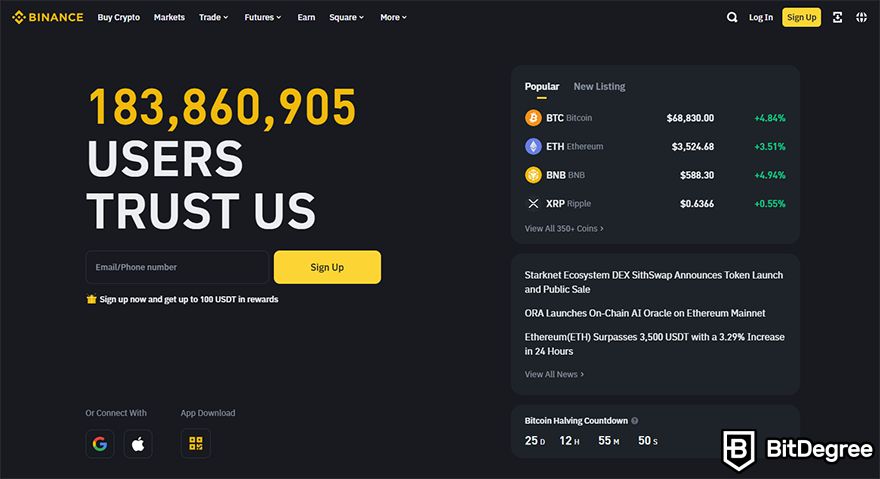
Binance is one of the giants in the crypto trading industry, popular for its extensive selection of cryptocurrencies and advanced trading features. It's a go-to platform for traders looking to apply their understanding of crypto patterns, complete with comprehensive chart tools and indicators that make identifying these patterns easier.
What sets Binance apart is its robust trading engine, capable of handling a vast volume of transactions without a hitch, allowing you to have a seamless trading experience. Additionally, its low trading fees and global availability make it a favorite among traders worldwide.
KuCoin

KuCoin is often referred to as "The People's Exchange." Why? It's because it grants access to some of the most innovative and lesser-known coins, making it an exciting platform for traders to discover potential hidden gems.
KuCoin's user-friendly interface simplifies tracking and trading processes based on crypto patterns, perfect for both novice and experienced traders. Moreover, its commitment to security and customer service ensures that you have a reliable and supportive environment for trading.

- Secure and reliable
- Accepts fiat currencies
- Lots of trading options
- Reputable exchange
- Accepts fiat currencies
- Offers various trading options

- Fiat currencies - accepted
- Simple to use
- Accepts only the most trustworthy cryptocurrencies
- A leading cryptocurrency exchange platform
- Best for beginner investors
- Accepts fiat currencies

- Fully reserved and transparent
- Multiple tradable asset classes
- Over 300 supported cryptos
- Over 300 cryptocurrencies
- Secure & transparent
- Fully reserved
Coinbase

Coinbase is popular for its simplicity and ease of use, making it an ideal starting point for beginner traders. While it might seem basic compared to Binance and KuCoin, Coinbase provides essential tools that allow you to identify and act on crypto patterns effectively.
Its focus on regulatory compliance and security builds trust among crypto traders, offering a safe platform for trading and investing. Additionally, Coinbase's educational resources help newcomers understand crypto patterns and how to leverage them for trading, setting it apart as a nurturing platform for developing trading skills.
Conclusion
We've covered some of the most common crypto chart patterns and gone over ten useful tips for technical analysis. They are an essential tool for traders navigating the often turbulent waters of the cryptocurrency markets. These patterns, ranging from simple lines to complex formations, help traders make educated guesses about where the market could head next.
However, it is important to note that these patterns are not flawless and they can’t guarantee a certain outcome. The cryptocurrency market is highly volatile, with prices capable of making dramatic shifts due to many factors, including regulatory news, technological advancements, and shifts in investor sentiment.
Consider applying risk management techniques, such as setting stop-loss orders to help protect your investments. Remember to keep learning and practicing your knowledge. After all, knowledge is your best tool when trading cryptocurrencies.
Don’t forget to check out Binance, KuCoin, and Coinbase when you start your crypto-trading journey as they offer great features that fit beginner and advanced traders alike.
The content published on this website is not aimed to give any kind of financial, investment, trading, or any other form of advice. BitDegree.org does not endorse or suggest you to buy, sell or hold any kind of cryptocurrency. Before making financial investment decisions, do consult your financial advisor.
Scientific References
1. Kristian R.: ‘Technical Analysis In Cryptocurrency Trading: A Historical and Analytical Investigation’;
2. Suwan L., Ying X., Zhengyuan Z., et al.: ‘From Whales to Waves: The Role of Social Media Sentiment in Shaping Cryptocurrency Markets’.

